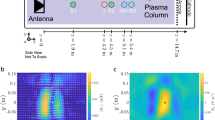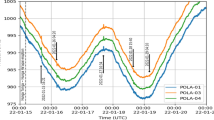Abstract
I READ Mr. Eckersley's interesting letter1 concerning the measurement of the collisional frequency of electrons in Region F of the ionosphere, but feel very doubtful whether, as he says, his measurements refer to Region F1. It seems to me that they must refer to Region F2, the highest and most densely ionised level of the ionosphere. At the time of his measurements (1605 on October 1, 1934), other observations, carried out at the Radio Research Station of the National Physical Laboratory, show that the extraordinary ray critical frequency for Region Fl was 4.2 me./sec. which is different from the value of 5 mc./sec. indicated by Mr. Eckersley. Moreover, since the ionisation in Region F1 exhibits a most regular type of seasonal and diurnal variation, with no abnormalities, it does not seem possible to account for the discrepancy as a local effect observed only at Chelmsford. It must also be pointed out that the formula previously given in a discussion of long-delay echoes for the ionospheric reflection coefficient, used by Mr. Eckersley, is an approximate one and its use in connexion with this particular problem does not seem justifiable. For the ordinary ray reflection coefficient we have, more accurately, where P and P are respectively the group and optical paths of the waves, is the electron collisional frequency and c the velocity of light. Since Mr. Eckersley's measurements yield values of P only, he has neglected entirely the value of P in the above formula, although it is known that P and P are of the same order of magnitude.
This is a preview of subscription content, access via your institution
Access options
Subscribe to this journal
Receive 51 print issues and online access
$199.00 per year
only $3.90 per issue
Buy this article
- Purchase on Springer Link
- Instant access to full article PDF
Prices may be subject to local taxes which are calculated during checkout
Similar content being viewed by others
References
NATURE, 135, 435; March 16, 1935.
Author information
Authors and Affiliations
Rights and permissions
About this article
Cite this article
APPLETON, E. A Method of Measuring the Collisional Frequency of Electrons in the Ionosphere. Nature 135, 618–619 (1935). https://doi.org/10.1038/135618b0
Issue Date:
DOI: https://doi.org/10.1038/135618b0
This article is cited by
-
Variation of Collision Frequency in the Lowest Ionosphere with Solar Activity
Nature (1964)
-
Propagation of radio waves reflected from the ionosphere during a solar eclipse
Geofisica Pura e Applicata (1960)
-
Das Nordlichtspektrum und der Zustand der Nordlichtregion
Die Naturwissenschaften (1938)
-
Ionospheric Disturbances, Fadeouts and Bright Hydrogen Solar Eruptions
Nature (1937)
-
Sugli agenti di ionizzazione dell’alta atmosfera
Il Nuovo Cimento (1937)
Comments
By submitting a comment you agree to abide by our Terms and Community Guidelines. If you find something abusive or that does not comply with our terms or guidelines please flag it as inappropriate.



